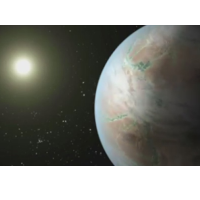NASA Announces Discovery of Earth-Like Planet
 Kepler 452b (image: NASA)
Kepler 452b (image: NASA)
A “cousin” to Earth has been located by National Aeronautics and Space Administration (NASA) scientists, raising the possibility that another planet may contain life on it.
NASA announced this week that the Kepler planet-hunting spacecraft had located a planet called Kepler 452b, 1,400 light-years away in the constellation Cygnus.
Even from that distance NASA was able to determine that Kepler 452b is larger than Earth, about 1.5 times the radius with five times the mass. More importantly, the exoplanet circles a sun-like star in an orbit that takes 385 days, just slightly longer than our own year.
These qualities put Kepler 452b in the so-called “Goldilocks” habitable zone that scientists say could result in lukewarm temperatures and liquid water on the surface.
However, they can’t determine is if Kepler 452b has a surface. It might consist of rock, like Earth, or it could be made of gas, like Neptune.
Jon Jenkins of NASA’s Ames Research Center, which runs the Kepler project, and lead author of a paper (pdf) being published in The Astronomical Journal, told The New York Times in an email that the likelihood of the planet being rocky was 50% to 62%, depending on how big its sun is.
“We can think of Kepler-452b as an older, bigger cousin to Earth, providing an opportunity to understand and reflect upon Earth’s evolving environment,” he said. “It’s awe-inspiring to consider that this planet has spent six billion years in the habitable zone of its star, longer than Earth. That’s substantial opportunity for life to arise, should all the necessary ingredients and conditions for life exist on this planet.”
-Noel Brinkerhoff
To Learn More:
NASA Says Data Reveals an Earth-Like Planet, Kepler 452b (by Dennis Overbye, New York Times)
NASA’s Kepler Mission Discovers Bigger, Older Cousin to Earth (National Aeronautics and Space Administration)
Discovery and Validation of Kepler-452b: A 1.6-R⊕ Super Earth Exoplanet in the Habitable Zone of a G2 Star (National Aeronautics and Space Administration) (pdf)
Scientists Boycott NASA Conference over Banning of Chinese Colleagues (by Noel Brinkerhoff, AllGov)
- Top Stories
- Unusual News
- Where is the Money Going?
- Controversies
- U.S. and the World
- Appointments and Resignations
- Latest News
- Trump to Stop Deportations If…
- Trump Denounces World Series
- What If China Invaded the United States?
- Donald Trump Has a Mental Health Problem and It Has a Name
- Trump Goes on Renaming Frenzy






Comments